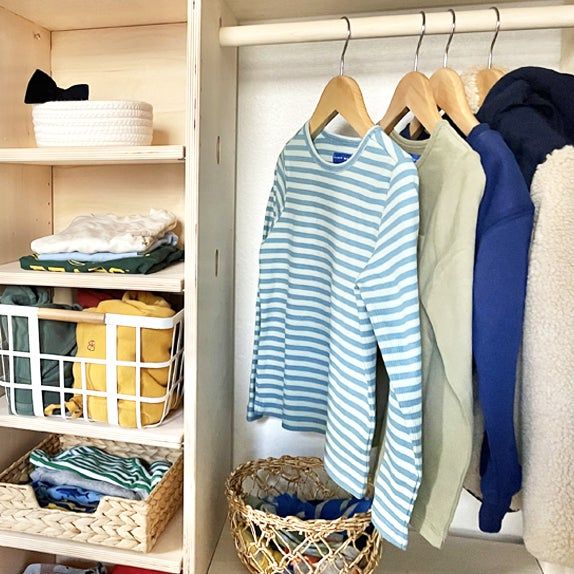
Ask An Expert
Empowering Your Child to Dress Themselves
“I do it myself!” we hear them say, as their arm struggles to find its way through the t-shirt, which may or may not be going on backwards. These are either moments of great pride or struggle for us and our child as getting dressed turns into a chaotic morning routine. These Montessori-inspired tips will give them more control and autonomy–and make your routine a more peaceful and collaborative part of the day.
- Photography
- Blanca Velazquez-Martin
- Written By
- Blanca Velazquez-Martin
Supporting a toddler's journey toward independent dressing may seem like a convenient way to free us, adults, from the task. Yet, if you have ever attempted to respect a child's wish to do it themselves, you know that supporting independence takes time and patience. It's far from being freed from the responsibility to support their self-care needs. The truth is, your active role in supporting the journey toward independent dressing can start before you hear your toddler screaming, "I do it!". It will still require your presence and support, but in a way that respectfully builds their independence and respects their choices.
Why should we support a toddler’s independence in such a tricky time of our morning routine?
While it may seem like the goal is to get your kids' clothes on, promoting independence is doing something much more powerful. When you prepare their environment for independence and prepare yourself with patience and realistic expectations in the process, you allow them to refine their motor skills, strengthen executive functioning skills, and build a sense of confidence and control over this part of their day. Most importantly, you trust them to be capable learners through an activity that does not require extra toys or materials but through a purposeful step in their routine that teaches self-care skills.
When we empower toddlers with appropriate control over key aspects of their routine, they feel trusted and respected and engage in the process more collaboratively. This collaboration leads to less chaos, fewer power struggles, and a toddler that begins their day feeling proud and accomplished.
And importantly, building independence toward self-dressing gives them a unique gift: full ownership of the process to prepare themselves for how they want to show up to the world that day in a way that feels true to them.
Now, where to begin?
Considering the following Montessori principles for guiding your child respectfully, preparing the environment for independence, and preparing yourself for the process are a wonderful place to start.
First, prepare the environment.
Create a space for independent self-dressing.
It could be a classic Montessori wardrobe, a low drawer in a n existing dresser dedicated only for them, a cube shelf turned DIY mini wardrobe with the help of a tension rod for hangers, or baskets lined up on the floor holding essential items. The key is to provide independent access for them to choose their clothing when it's time – from a place that feels like their own. How you do this should fit your preference, budget, and space needs. Your child will value independence and trust, not necessarily a fancy setup.
Offer tools that support independent dressing.
You are likely modeling sitting down to put your socks on and using a mirror while getting dressed in the morning. Offer them the same tools for success, adapted to their stage in motor development. Add a step stool or chair to fit their height, tapping it gently as an offer for them to use in the process. Install a low-hanging mirror nearby to see their movements in the process and learn body awareness.
Choose clothing for developing independently with ease.
In general, any soft, loose piece of clothing with no buttons or snaps is a wonderful place to start.
• Opt for bottoms with elastic waistbands they can pull up on their own, instead of zippers or buttons they can’t yet maneuver (for dressing and undressing!).
• Look for soft and wide neck openings for both shirts and dresses without snaps or buttons for tops. Loose shirts make it easy to find the armholes and push their arms through.
• Look for ankle-height socks instead of long socks or tights. Socks that are too big for them are terrific for practicing dressing motions successfully, even if it's just for play during the day.
• Slip-on shoes or shoes with a velcro closing, instead of a buckle or laces, can help them feel accomplished until they are ready to navigate tying shoes.
These recommendations do not mean that ornate, beautiful, and more elegant pieces of clothing are not an option–find a balance that makes sense for your family culture and preferences and special occasions.
Offer freedom, within limits.
A key aspect of making independent dressing a collaborative process is providing your toddler with a sense of control and ownership of this step in their morning routine. Yet, we give this freedom considering your child's developmental needs and abilities. It sounds like a tricky balance because there is no magic formula, as each child's development (and even level of interest in participating!) is unique.
Start by offering two options for each item of clothing, such as two pairs of socks, two shirts, two pairs of leggings, etc., and invite them to make a choice. Opportunities to make choices are essential, but too many options can become overwhelming, lead to power struggles, and clothes can end up on the floor. A clear choice between two items sends a clear message about the purpose of the activity as an invitation with a clear goal: "Time to get dressed! Would you like to wear the blue shirt or the red shirt?" Is the season changing? Try to prepare reasonable choices for the weather: if you make them available, they are fair game.
It may seem daunting, but steps to prepare the environment may keep you from having to redirect your child away from choices that are not appropriate for the weather or prevent struggles and tears. Instead, you'll be able to focus on your child learning through offerings you already made fair game for them. First, we offer appropriate choices and honor and respect those choices.
Also, prepare yourself: for things to take longer and yield imperfect yet joyful results.
Set yourself up for success
Arm yourself with patience and extra time whenever possible. When pressed with time, we inadvertently or unintentionally communicate impatience and lack of trust in their process. If you are just getting started, present the new prepared environment during the weekend when you both have ample time to navigate the new dressing routine, and build from there. Approach the rest of the week knowing you may need a little extra time for getting dressed in the morning.
Pause
Just when you think your child would benefit from your help, just as you feel your hand wanting to reach in pause. That pause, with your calm and reassuring presence, can be the difference between you taking over and them receiving a message of trust that lets them accomplish things on their own with joy and pride. Encourage your toddler respectfully by reassuring them, "I'm here!", "I see you are working so hard" or "I'm here if you need help," and waiting for them to ask for help instead of jumping in before needed.
Guide gently for gradual progress
Full independence with each piece of clothing requires many steps. Think about all the body movements it takes simply to put a t-shirt on! Walk your child through these steps slowly, placing close attention to how your child’s body gradually catches on as a cue for you to keep your hands away and give them a chance to master that next step.
• For tops, begin by placing the shirt over your child’s head and offer them to pull down. From there, walk them through the next step for their hands to find the armholes.
• For bottoms, place your child’s feet inside the leg openings while sitting, and then ask them to pull them up as they stand. A simple look at their accomplishment in the mirror you placed nearby will make this a joyful moment they will want to repeat the next day. Eventually, you can model how to hold bottoms near their feet to help their legs make their way in independently.
• Place socks on the tip of their foot and ask them to pull the rest of the way up! When their hands seem ready, model how to place thumbs inside to widen the opening and fit their foot inside. Remember the extra big sock recommendation? Playing dress-up with clothing that is too big for them can be a powerful way to practice.
• Try the Montessori coat flip! Place the coat on the floor with the opening facing up, exposing the sleeve openings. Have your child stand at the side with the hood and label, then guide them to place their hands into the sleeves as they raise their arms to flip the coat over their head for the coat to slide into their arms. (Try this visual from The Montessori Notebook)
Guide, instead of correcting
"But his shirt is on backward!" I know, I know… but it's on, and they put it on independently! Beyond independence, they are developing a strong sense of self-reliance, self-esteem, and pride in the process. That is what we celebrate, respect, and honor in those moments.
As your child navigates this routine more confidently, they will fine-tune the process. Remember that much of what we notice in the dressing process comes from a level of body awareness and attention to detail that your child may not have yet developed. When you meet them where they are and celebrate what they consider an accomplishment, you nurture their internal motivation to keep trying. They will get there, so we don't correct their efforts. We simply celebrate them and wait for them to learn something new the next time. As Dr. Maria Montessori said it herself: "Teach by teaching, not by correcting."
If it feels tricky or imperfect along the way, it is because there is no magic formula, and each child masters the process on their own time. In the end, remember that we care about independent dressing as part of their growth, not because it is convenient--in fact, it may take longer as they learn! We do this because we want to foster a love for learning, which comes from an internal motivation to confidently and collaboratively engage in purposeful work and self-care skills.
Blanca Velazquez-Martin

Inspired by her journey as child psychotherapist, psychosocial research professional, and parent, Blanca launched Whole Child Home as a space to share some of this research and leave you with evidence-based information that you can use to help support your child’s development at home.
Whole Child Home integrates inspiration from the Montessori philosophy, driven by Blanca's own experience as a Montessori child, and now a Montessori parent. The Montessori method is based on scientific observation, and now has research to support its principles as ways to enrich many areas of child development—of the whole child.